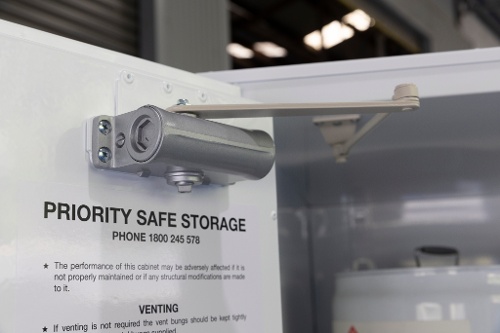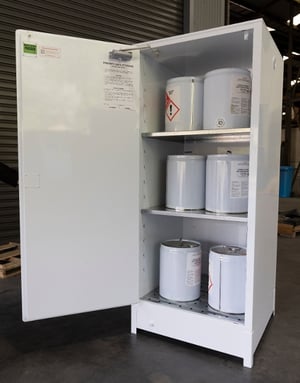Before You Install Your Cabinet
- Select an appropriate location that is safe, compliant and convenient for staff to access it. Make sure the cabinet location does not impede emergency exits or evacuation routes.
- Check the site is flat, level and capable of holding the weight of the filled cabinet.
- Remove any potential hazards from the area, such as ignition sources or incompatible substances.
- Clear and clean the placement site, disposing of rubbish, combustible materials and any other potential hazards.
REMEMBER: It’s a good idea to have operating procedures for the cabinet already in place, so staff can be trained to use it correctly.
Installation
- Using a trolley or stair lifter, retrieve the cabinet from the delivery area (leaving the packaging on.) Take the cabinet to the installation location.
- Carefully unwrap the cabinet and remove it from the wooden pallet.
- The cabinet will already be equipped with footing that allows it to be put in place on the flat, even surface with little to no fuss.
- Position the cabinet in the required location.
- Configure the perforated shelving to suit your requirements. To adjust, simply lift up the shelf from the lugs, which are inserted into the cabinet interior wall. Put the lugs in the new position and place the shelf securely on top.
IMPORTANT: If you have also purchased a document holder, attach it to the side of your cabinet and fill with the relevant Safety Data Sheets.
Door Closing System
- To ensure that the sequential door closing system works correctly, the safety cabinet must be installed on a level base.
- If doors are not closing and latching correctly, the appropriate corner of the cabinet should be lifted slightly and packed until the doors are level and latch automatically.
- These door closing speeds can be changed by using the adjustment screw on the hydraulic door closer itself.

Venting
- If venting is not required on your safety cabinet, the vent bungs should be kept tightly capped with the metal bung plugs supplied.
- If venting is required only an approved venting system should be used and fitted according to the requirements of your local regulatory authority. You can find more information on how to ventilate dangerous goods storage cabinets by downloading our FREE safety cabinet ventilation guide.
- Safety cabinet venting should never be manifolded through a series of dangerous goods storage cabinets. A ventilation system for a safety cabinet must never be connected to a standard laboratory hood.
Post-Installation Check
- Check that the cabinet has not suffered damage during the moving or installation process.
- Inspect the doors to ensure that they are closing tightly and in sequence.
- Make sure that all dangerous goods and hazard signage is in place.
Maintenance
- Create a regular inspection and maintenance schedule to ensure your cabinet stays compliant.
- Make sure that any chemical leaks or spills within the cabinet are cleaned up immediately. If any dangerous goods spill into the sump of the cabinet, the floor of the cabinet must be removed, so the sump can be cleaned out immediately.
- Regularly check the doors to ensure that the self-closing, self-latching door mechanism is working correctly.
- If PVC spill trays are installed in your cabinet (metallic corrosive storage cabinet models only) ensure that the trays are kept clean on top and underneath the prevent corrosion.

REMEMBER: If dangerous goods are left in the sump, they will start to fume. This can lead to asphyxiation and health issues in workers. Unclean sumps can also create chemical hazards such as fire or explosion.
Download Product Manual PDF
Video tutorials:
Watch Storemasta's video tutorials to find out how to use and maintain your equipment.
- Adjusting the Door Closing Speed on your Cabinet
- Ensuring Your Storemasta Cabinet Latches Properly
- How to Identify and Safely Clean Spills in a Corrosive Chemical Cabinet
Further resources:
Click on the below links for more information about dangerous goods storage indoors.
- 10 Top Tips For Maintaining Compliant Chemical Cabinets
- What Can You Store In A Chemical Cabinet?
- Inspection Checklist Essentials For Chemical Storage Cabinets
Get in touch:
Need some more advice on the installation or use of your dangerous goods storage cabinet? It’s easy to get in touch with our team. Call us or connect online for expert advice on solutions that can effectively reduce your risk.
Joining the team as a Dangerous Goods Storage Consultant, Melissa Hampton became Storemasta's Marketing Manager in late 2021. With extensive knowlege and experience in chemical compliance, Melissa is responsible for leading the Marketing team and helping shape their marketing strategy. In her spare time, you can find Melissa hiking, swimming and enjoying the great outdoors in beautiful north-west Tasmania.